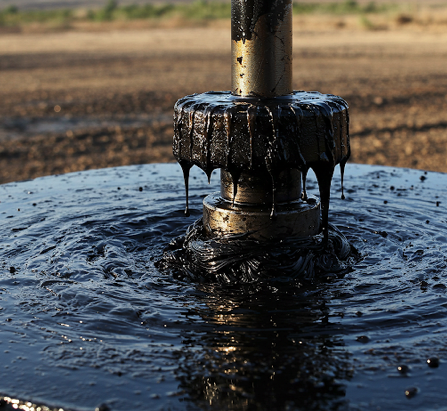Crude Oil
 Crude oil, often referred to simply as "crude," is a naturally occurring, unrefined petroleum product composed of hydrocarbon deposits and other organic materials. It is a fossil fuel formed over millions of years from the remains of ancient marine organisms, such as plankton and algae, which were buried under layers of sediment and subjected to intense heat and pressure. Crude oil is typically found in underground reservoirs or porous rock formations and is extracted through drilling. Its composition varies widely, containing a complex mixture of hydrocarbons, including alkanes, cycloalkanes, and aromatic hydrocarbons, along with trace amounts of sulfur, nitrogen, and oxygen compounds. The quality and characteristics of crude oil, such as its viscosity and sulfur content, determine its classification as "light" or "heavy" and "sweet" or "sour," which influence its suitability for refining into products like gasoline, diesel, jet fuel, and petrochemicals. Crude oil is a critical global energy resource, driving industries and economies, but its extraction, refining, and use also raise environmental concerns due to carbon emissions and potential spills.
Crude oil, often referred to simply as "crude," is a naturally occurring, unrefined petroleum product composed of hydrocarbon deposits and other organic materials. It is a fossil fuel formed over millions of years from the remains of ancient marine organisms, such as plankton and algae, which were buried under layers of sediment and subjected to intense heat and pressure. Crude oil is typically found in underground reservoirs or porous rock formations and is extracted through drilling. Its composition varies widely, containing a complex mixture of hydrocarbons, including alkanes, cycloalkanes, and aromatic hydrocarbons, along with trace amounts of sulfur, nitrogen, and oxygen compounds. The quality and characteristics of crude oil, such as its viscosity and sulfur content, determine its classification as "light" or "heavy" and "sweet" or "sour," which influence its suitability for refining into products like gasoline, diesel, jet fuel, and petrochemicals. Crude oil is a critical global energy resource, driving industries and economies, but its extraction, refining, and use also raise environmental concerns due to carbon emissions and potential spills.
- Alkanes (paraffins) – straight or branched chains (e.g., methane, octane)
- Cycloalkanes (naphthenes) – saturated ring structures (e.g., cyclohexane)
- Aromatic Hydrocarbons – ringed structures with delocalized electrons (e.g., benzene, toluene)

